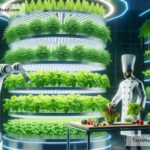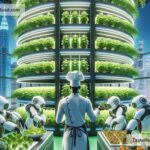The Future of Food and Transformative Sustainability Models
Food is essential to human life, but the way we produce, distribute, and consume food is changing. The future of food is a topic of global importance as we face growing populations, environmental challenges, and a need for healthier diets. To address these challenges, innovative sustainability models are paving the way for new solutions. In this blog, we’ll explore where the future of food is headed and how transformative changes in agriculture, technology, and consumption can create a better world for everyone.
The Challenges We Face
Our global food system has some big problems. First, the world’s population is predicted to grow from 8 billion today to nearly 10 billion by 2050. Feeding billions of people will require smarter ways to grow and distribute food.
Second, farming and food production significantly impact the environment. Agriculture uses large amounts of water and land, contributing to deforestation, soil erosion, and biodiversity loss. Additionally, the production of meat results in greenhouse gas emissions that drive climate change. If we continue down this path, the planet may struggle to sustain us.
Finally, food systems don’t always provide healthy options. Overconsumption of processed and sugary foods contributes to global health problems, while millions still suffer from hunger and malnutrition. This imbalance highlights the need for a fairer and more sustainable food system.
Sustainability Models Transforming Food Production
To tackle these big problems, experts are working on sustainability models that rethink how food is grown, processed, and consumed. Here are some of the most exciting transformations shaping the future of food:
1. Precision Agriculture
Technology is changing farming. Precision agriculture uses tools like drones, GPS systems, and sensors to monitor crops and soil conditions. Farmers can make data-driven decisions to water plants or apply fertilizers only where they’re needed. This reduces waste and minimizes the environmental impact of farming. By using land more efficiently, farmers can grow more food with fewer resources.
2. Vertical Farming
In vertical farms, crops are grown indoors in stacked layers or towers. These farms rely on advanced technologies like LED lighting and hydroponics (growing plants without soil). Vertical farms save space and use far less water than traditional farming methods. Since they can be built in cities, they also reduce the energy required to transport food from farms to consumers. Vertical farming is revolutionizing how we grow fresh produce.
3. Alternative Proteins
Most people get their protein from meat, but raising animals uses enormous resources and impacts the environment. Scientists and companies are developing alternative proteins, including plant-based meat substitutes, cultured meat (grown from animal cells), and proteins derived from insects and algae. These innovations offer the nutrition we need while being kinder to the planet.
4. Regenerative Agriculture
Regenerative agriculture takes farming a step further by improving soil health and helping reverse climate change. Instead of using practices that harm the land, this method emphasizes planting diverse crops, reducing chemical use, and preserving natural ecosystems. Healthy soil absorbs carbon dioxide, making it a powerful tool for fighting climate change. Regenerative agriculture helps farmers produce food while caring for the planet.
5. Smart Food Packaging
Plastic waste from food packaging is a major environmental issue. To combat this, companies are creating biodegradable and reusable packaging materials. Some innovations even incorporate edible packaging made from seaweed or starch. Smart packaging also uses sensors to monitor freshness, helping reduce food waste. These designs are helping us transition to an eco-friendly consumer experience.
Changing the Way We Eat
Another part of building a sustainable future is changing how people think about food. Here are a few ideas that are gaining attention:
1. Reducing Food Waste
Nearly one-third of all food produced globally goes to waste. That’s enough to feed billions of people! By planning meals, donating excess food, and improving storage technologies, we can cut food waste significantly.
2. Supporting Local Food Systems
Buying food from nearby farmers instead of importing it from far away strengthens local economies and reduces transportation emissions. Community-supported agriculture and farmers’ markets are great examples of how we can make food systems more sustainable.
3. Eating More Plant-Based Foods
Eating less meat and more plant-based foods is one of the simplest ways to reduce your carbon footprint. Fruits, vegetables, grains, and legumes require fewer resources to grow, making them better for the planet.
The Role of Innovation
The future of food also depends on breakthroughs in technology and science. For example, artificial intelligence (AI) is helping farmers predict weather patterns and manage crops efficiently. Advanced genetics are improving plant varieties to make them more resistant to drought or pests. And 3D printers are even creating edible food items! Together, these innovations are pushing the boundaries of what’s possible in food production.
A Sustainable Food Revolution
The future of food isn’t just about feeding more people—it’s about doing it in a way that protects the planet and promotes health and fairness. Transformative sustainability models, from vertical farming to biodegradable packaging, show us that change is not only possible but necessary.
Governments, businesses, and individuals all have a role to play in this revolution. By adopting cleaner, smarter, and healthier practices, we can create a food system that sustains both humanity and the Earth.
The road ahead is challenging, but with creativity and collaboration, the future of food looks bright. It’s not just about what’s on our plates; it’s about building a sustainable world for future generations.
What do you think the future of food will look like? Share your thoughts in the comments!


